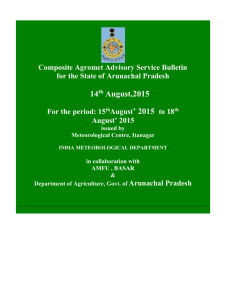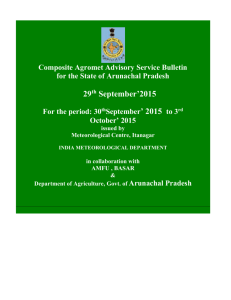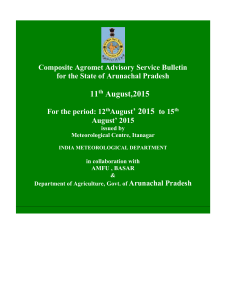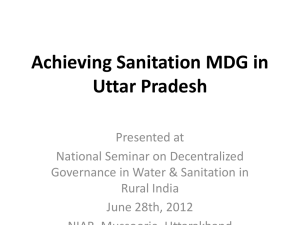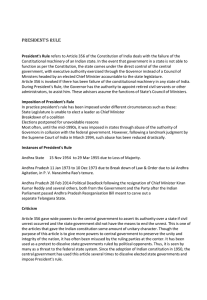Wind Resource Assessment Techniques Presentation
advertisement
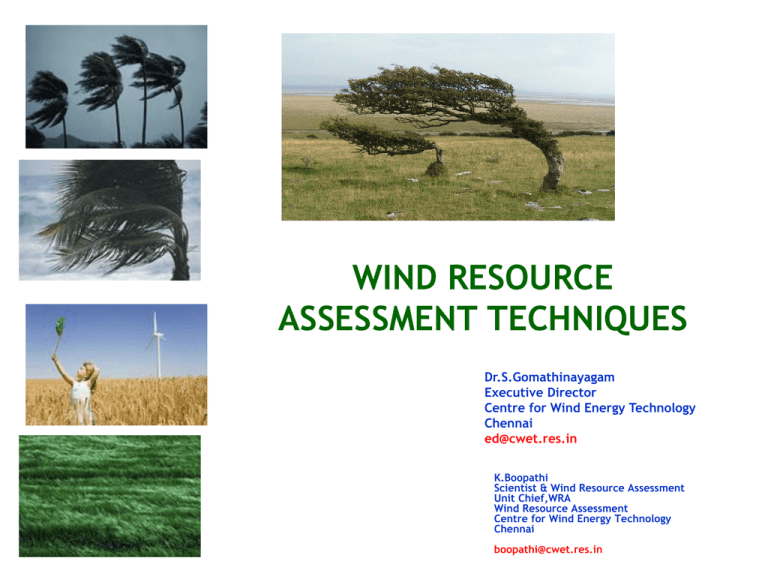
WIND RESOURCE ASSESSMENT TECHNIQUES Dr.S.Gomathinayagam Executive Director Centre for Wind Energy Technology Chennai ed@cwet.res.in K.Boopathi Scientist & Wind Resource Assessment Unit Chief,WRA Wind Resource Assessment Centre for Wind Energy Technology Chennai boopathi@cwet.res.in WIND Air in motion i.e. motion of air relative to the earth’s surface. Free, clean and inexhaustible energy It is intermittent source One day it calm, howling next It will vary place to place and time to time WIND RESOURCE-GLOBAL WIND SYSTEM All renewable energy (except tidal and geothermal power), and even the energy in fossil fuels, ultimately comes from the sun. About 1–2% of the energy coming from the sun is converted into wind energy The region around equator at 0 deg latitude are heated more by the sun than the rest of the globe. Due to this flow of air takes place from the cold regions to hot regions. Wind speed characteristics Horizontal and Inter annual Variability Vertical Wind Variability Temporal and Inter annual Variability Atmospheric boundary layer and Vertical wind profile Vertical wind profile for different roughness lengths z0, assumed “geostrophic wind” of 15 m/s Wind Regime in India Wind climatology in India is influenced by the strong monsoon circulations South west monsoon during May to Sept brings the best winds Wind speed during November to March is low, except in Southern tip of Tamil Nadu Best Windy Sites are in Kerala, Karnataka, Tamil Nadu, Gujarat, Andhra Pradesh and Maharashtra POWER IN THE WIND From Wind to Electric Power Power (translation) = Force x Velocity (P=F V) or Power (rotation) = Torque x rotational speed (P=T x co) P= KE*m KE - Kinetic Energy ,=1/2mV 2 m - mass flow rate=pAV Pwind = Cp 1/2 pV3 A Cp efficiency (“Betz” max. = 16/27) 1/2 pV2 Dynamic pressure at 1 m2 p Air density (~1.22 kg/m3) V Wind speed A Gross rotor area Wind Resource Assessment Main objective is to identify potentially windy areas that also possess other desirable qualities for wind project development WIND RESOURCE ASSESSMENT TECHNIQUES Prospecting (Large area Screening & Field visits). Validation (Wind measurements & Data Analysis) Micro Survey & Micrositing. PROSPECTING PROSPECTING STEPS ● ● ● ● ● Preliminary area identification Ranking of candidate sites Selection of tower location(s) Development of a monitoring plan Quality assurance Preliminary Area Identification Objective is to determine or verify whether sufficient wind resources exist within an area to justify further site-specific investigation Large area screening- wind resource map look up use of existing wind data-nearby airport topographic indicators field surveys flagged trees accessibility land use– obstructions available land area Large area Screening and Existing data • large-area screening usually begins with a review of – existing wind resource maps, data and other meteorological informations (pressure, temperature etc.) – analysis of the climatology of the region along with the topographical maps (such as terrain form, land use and land cover, and other logistics like accessibility, grid availability etc.). use of existing wind data-nearby airport nearby airport measurement wind data Long term re analysis data (NCEP/NCAR/MERRA) WPAD MAP AT 50 m States / UTs Andaman & Nicobar Andhra Pradesh Arunachal Pradesh* Installable Potential (MW) 50 m Level 2 5394 201 Assam* 53 Chhattisgarh* 23 Gujarat 10609 Himachal Pradesh * 20 Jammu & Kashmir * 5311 Karnataka 8591 Kerala Lakshadweep Madhya Pradesh Maharashtra Manipur* Meghalaya * Nagaland * Orissa Rajasthan Sikkim * Tamil Nadu 790 16 920 5439 7 44 3 910 5005 98 5374 Uttarakhand * 161 Uttar Pradesh * 137 West Bengal* Total 22 49130 State Name Andaman &Nicobar Islands Andhra Pradesh Arunachal Pradesh* Assam* Bihar Chhattisgarh* Dieu Damn Gujarat Haryana Himachal Pradesh * Jharkhand Jammu & Kashmir * Karnataka Kerala Lakshadweep Madhya Pradesh Maharashtra Manipur* Installable Potential MW 365 14497 236 112 144 314 4 35071 93 64 91 5685 13593 837 16 2931 5961 56 Meghalaya * 82 Nagaland * Orissa Pondicherry Rajasthan Sikkim * Tamil Nadu Uttarakhand * Uttar Pradesh * West Bengal* Total 16 1384 120 5050 98 14152 534 1260 22 102788 TOPOGRAPHIC INDICATORS Field visits To look for physical evidence to support the wind resource estimate developed in the largearea screening. Another purpose of the site visit is to select a possible location for a wind monitoring station. Consistently bent trees and vegetation, for example, are a sure sign of strong winds. Ranking of Candidate Sites Objective is to compare areas to distinguish relative development potential In addition to accessibility, land use, obstructions, and available land area, siting criteria could include: proximity to transmission lines potential impact on local aesthetics cellular phone service reliability for data transfers potential avian interactions Standard Wind Class US Wind Class A site can be classified as one of the Standard seven classes depending on Wind Power Density/Wind Speed available at 50 m above ground. Class Speed(m/s) WPD(W/Sq.m) 1 0-5.6 0-200 2 5.6-6.4 200-300 3 6.4-7.0 300-400 4 7.0-7.5 400-500 5 7.5-8.0 500-600 6 8.0-8.8 600-800 7 8.8-11.9 800-2000 Site Selection The power output of a wind rotor Increases with the cube of the wind speed. This means that the site for a windmill must be chosen very carefully to ensure that the location with the highest wind speed in the area is selected. The site selection is rather easy in flat terrain but much more complicated in hilly or mountainous terrains. A number of effects have to be considered : 1. 2. 3. 4. 5. 6. 7. winds hear; the wind slows down, near the ground, to an extent determined by the surface roughness. turbulence; behind building, trees, ridges etc acceleration; (or retardation) on the top of hills, ridges etc. Inflow wind Extreme wind Gusts Wake effects Turbulence and Acceleration of ridge and Obstacle The flow inclination must not exceed ± 8 degree for any wind direction Turbulence is variations in wind speed Close to an obstacle such as a building the wind is strongly influenced by the presence of the obstacle. The effect extends vertically to approximately three times the height of the obstacle, and downstream to 30 to 40 times the height. If the point of interest is inside this zone, it is necessary to take the sheltering effects into account, whereas if the point is outside the zone the building should be treated as a roughness element. The buildings and rows of trees shelter the met. mast in the centre of the drawing. •Back ground turbulence •Wake turbulence tops of ridges experience higher wind speeds due to the effect of wlndshear The ideal slope angle is said to be 16° (29 m rise per 100 m horizontal distance) but angles between 6° and 16° are good VALIDATION Met Mast Instruments for Measuring wind speed and Direction cup anemometer vane anemometer ultrasonic anemometer hot-wire anemometer other “high-tech” device (SODAR,LIDAR) Instruments small vertical axis wind wheel rotational speed proportional to wind speed two ways taco generator (analogue signal) frequency signal (optoelectronic) most commonly used, sufficient for most tasks in wind technology wide range of qualities Direction of wind is an important factor in the siting of a wind energy conversion system. If we receive the major share of energy available in the wind from a certain direction, it is important to avoid any obstructions to the wind flow from this side. Wind vanes were used to identify the wind direction in earlier day’s anemometers logging of time series (10-minute or 1-hour averages) channels for 3 or more wind speeds and wind vanes, air pressure, 2 or more temperatures, humidity power supply by solar panel and battery safety system for data storage in case of break down of power supply data storage capacity minimum of 2 months vertica l REMOTE SENSING INSTRUMENTS ea st SODAR Analysis • • number of manipulations with these data, basically looking at two aspects: time distribution frequency distribution Plotting the monthly averages of each hour of the day shows the diurnal fluctuations of the wind speed in that particular month Monthly variation Diurnal variation Minimum information to be contained in wind data files: Mean wind speed measured at two heights. E.g. 30m and 50 m or if possible hub height. Measurements at two heights are needed in order to investigate the wind shear. Standard deviation over a 10 minutes period in order to determine turbulence. Wind direction. In order to determine main wind directions. All the information must be saved in a text file or ASCII file (e.g. *.xls /*.prn /*.tab*.dat /*.asc /*.txt/). TECHNIQUES FOR ESTIMATING WIND RESOURCES • These techniques can be used screen candidate resource areas for sites with high potential or to estimate wind energy characteristics at a specific location. • numerical modeling of flow over terrain • physical modeling of flow over terrain • topographical indicators of wind energy potential • biological indicators of wind energy potential • geomorphol ogi cal indicators of wind energy potential • social and cultural indicators of wind energy potential. • Numerical Modeling Synoptic scale -is a horizontal length scale of the order of 1000 kilometres (about 620 miles) or more Meso-about 5 kilometers to several hundred kilometers Micro-1 km or less, smaller than mesoscale WIND RESOURCE ASSESSMENT UNIT Offshore Wind Mapping • • • • • • Study based on coastal wind monitoring stations. Study based on data from data buoy deployed by NIOT. Study based on SAR in association with RISO –DTU Study based on QUICK SCATT in association with INCOIS SDI, Scotland has been encaged for preparing feasibility study. Measurements are being initiated at Dhanushkodi in Ramanathapuram, Tamil Nadu SAR winds • • • ENVISAT ASAR WSM images from the European Space Agency (ESA). The WSM – Wide Swath Mode – scenes each cover 400 km x 400 km. As examples two of the wind maps are shown in Figure. The figure 1(top) shows an example from 4 December 2010 characterized by strong winds whereas the Figure 2 (bottom )shows much weaker winds on 25 September 2010. A total of 164 WSM scenes are used. Most of the 164 scenes are from ESA’s ordering system EOLISA and sent on DVD to Risø DTU but a few are taken from ESA’s rolling archive. There are a total of 164 ocean wind maps out of which 72 are observed in the morning and 92 in the evening Ocean wind map from ENVISAT ASAR WSM from 4 December 2010 at 04.30 UTC in South India. • Ocean wind map from ENVISAT ASAR WSM from 25 September 2010 at 04.43 UTC in South India. OFFSHORE WINDFARM (PROPOSED) AT DHANUSKODI RAMESHWARAM AND KANYAKUMARI MICROSURVEY & MICROSITING MICRO SURVEY What is micro siting ? Micro siting is a way to optimize the park layout in any given site to give the optimum production on site. - Wind measurements - Roughness, Obstacles, Orography - Wind resource estimate - Turbine layout - Production estimate, incl. wake losses to other turbines - Load calculation to ensure a 20 year design lifetime - Calculate sound emission from the turbines to the nearest neighbor. - Create a visualization of the park. - Calculate shadow flickering -Recommend another turbine type, turbine layout, hub height, wind sector management or measurement campaign All this is something that is done before the park is erected so you can calculate the feasibility of the project. Benefits of siting • Optimize production • Analyze and reduce risks Conclusions The wind resource drives project viability. Wind conditions are site-specific and time/height variable. Accuracy is crucial. Wind resource assessment programs must be designed to maximize accuracy. Combination of measurement and modeling techniques gives the most reliable result. Know the uncertainties and incorporate into decision making. Good financing terms depend on it. Thank you


